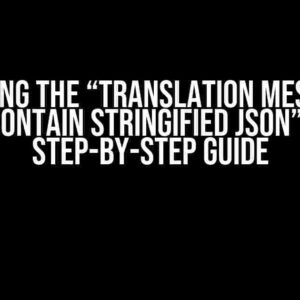As developers, we’ve all been there – digging through lines of code, trying to pinpoint the source of a pesky error. And what do we often stumble upon? The enigmatic Error.captureStackTrace(err, this). But what does it do, exactly? In this article, we’ll delve into the depths of this cryptic function and uncover its secrets.
What is Error.captureStackTrace(err, this) ?
Error.captureStackTrace(err, this) is a method used in Node.js to capture the stack trace of an error object and preserve its original error message, name, and other properties. It’s a lifesaver when debugging errors in asynchronous code, but its cryptic syntax can leave even the most seasoned developers scratching their heads.
Breaking Down the Syntax
Error.captureStackTrace(err, this)
Let’s dissect the syntax:
err: The error object whose stack trace we want to capture. This can be a custom error or a built-in error type.this: The context in which the error is being captured. This is often the current object instance or a specific scope.
The Problem with Error.captureStackTrace(err, this)
So, what’s the issue with this magical method? Well, it’s not as straightforward as it seems. Here are some common pitfalls to watch out for:
1. The ‘this’ Conundrum
The this keyword can be notoriously finicky in JavaScript. If you’re not careful, it can lead to unexpected behavior and errors. When using Error.captureStackTrace(err, this), make sure you understand the context in which this is being referenced.
function MyError() {
Error.captureStackTrace(this, this.constructor);
}
In this example, this refers to the MyError function’s context. However, if you’re using an arrow function or a callback, the this keyword can have a different meaning.
2. Custom Error Objects
When creating custom error objects, it’s essential to call the Error.captureStackTrace(err, this) method to preserve the original error’s properties. Failing to do so can lead to incomplete or misleading error messages.
class CustomError extends Error {
constructor(message) {
super(message);
Error.captureStackTrace(this, this.constructor);
}
}
3. async/await and Error Handling
In asynchronous code, error handling can get tricky. Make sure to wrap your asynchronous code in a try-catch block and use Error.captureStackTrace(err, this) to capture the error’s stack trace.
async function myAsyncFunction() {
try {
// async code here
} catch (err) {
Error.captureStackTrace(err, this);
console.error(err);
}
}
Best Practices and Workarounds
To avoid the common pitfalls, follow these best practices and workarounds:
1. Use a Consistent ‘this’ Context
Avoid using the this keyword whenever possible. Instead, use a consistent context or object instance to ensure predictable behavior.
const errorContext = {};
Error.captureStackTrace(err, errorContext);
2. Preserve Error Properties
When creating custom error objects, always call Error.captureStackTrace(err, this) to preserve the original error’s properties.
class CustomError extends Error {
constructor(message) {
super(message);
Error.captureStackTrace(this, this.constructor);
this.name = 'CustomError';
this.message = message;
}
}
3. Use a Centralized Error Handling Mechanism
Implement a centralized error handling mechanism to catch and handle errors globally. This can include a custom error handler or a library like sentry.
process.on('uncaughtException', (err) => {
console.error(err);
// Send error to error tracking service
});
Conclusion
The mysterious Error.captureStackTrace(err, this) method is a powerful tool in the world of Node.js error handling. By understanding its syntax, avoiding common pitfalls, and following best practices, you can unlock its full potential and debug errors like a pro.
| Common Pitfalls | Solutions |
|---|---|
| The ‘this’ Conundrum | Use a consistent ‘this’ context or object instance |
| Custom Error Objects | Call Error.captureStackTrace(err, this) to preserve error properties |
| async/await and Error Handling | Wrap async code in try-catch blocks and use Error.captureStackTrace(err, this) |
Remember, with great power comes great responsibility. By mastering Error.captureStackTrace(err, this), you’ll be well on your way to becoming an error-handling ninja.
Further Reading
Now, go forth and conquer those pesky errors with the power of Error.captureStackTrace(err, this)!
Frequently Asked Question
Get the inside scoop on one of the most frustrating error-handling phrases in Node.js – Error.captureStackTrace(err, this)!
What does Error.captureStackTrace(err, this) do, and why do I need it?
Error.captureStackTrace(err, this) is a sneaky little method that captures the current stack trace and attaches it to the error object (err) as its own stack property. It’s like taking a snapshot of the error’s ancestry, so you can later examine where it came from. You need it to preserve the original error stack trace, especially when working with async code or when you’re handling errors in a separate context.
What’s the difference between Error.captureStackTrace(err, this) and err.stack?
Error.captureStackTrace(err, this) is like calling a photographer to capture the error’s stack trace, whereas err.stack is like looking at the photo album. The first one sets the stack property, and the second one simply returns the existing stack property. If you don’t call Error.captureStackTrace(err, this), err.stack will be empty or incomplete, leading to headaches when trying to debug.
Why does Error.captureStackTrace(err, this) need the ‘this’ context?
The ‘this’ context is crucial because it tells Error.captureStackTrace() where to start capturing the stack trace from. Think of it like specifying the starting point for the photographer to take the snapshot. If you omit ‘this’, the method will capture the stack trace from the point where Error.captureStackTrace() is called, which might not be what you want.
Can I use Error.captureStackTrace(err, this) with custom error classes?
Absolutely! As long as your custom error class inherits from the built-in Error class, you can use Error.captureStackTrace(err, this) to capture the stack trace for your custom errors. Just remember to call the Error constructor and set the prototype correctly, and you’re good to go!
Is Error.captureStackTrace(err, this) only for Node.js or can I use it in browser-side JavaScript?
Sorry, browser-side JavaScript developers! Error.captureStackTrace(err, this) is a Node.js exclusive, and you won’t find it in browser-side JavaScript. However, you can use the console API or other libraries to achieve similar error-handling functionality in the browser.



